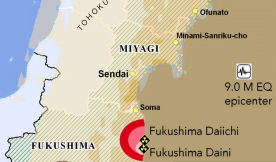The UN Office for the Coordination of Humanitarian Affairs has published a new update on the aftermath and response to the the Japanese earthquake and tsunami.
Casualties
The number of casualties continues to rise. More than 21,911 are dead and missing: 8,649 confirmed deaths, 13,262 missing, and 2,644 injured. The electricity supply is improving each day with power now restored for 234,000 persons in the last few days. Only 244,000 households remain without electricity (601,000 people). Access to water is still a concern however and 1 million households (2.4 million people) remain without water across 11 Prefectures.
Fukushima Nuclear Plant
Electricity has been restored to three reactors at the Fukushima Nuclear Power Plant; however, the cooling systems are not yet operating. Some workers at the facility were temporarily evacuated after smoke was seen rising from reactor No 3. The International Atomic Energy Agency (IAEA) says there have been positive developments at the site. The IAEA said smoke or vapour rising from one of the overheating reactors at the damaged Fukushima power plant had become less intense. But it said the overall situation remained very serious. Radioactive contamination has been detected in some milk, water and vegetables – but below levels that are a concern.
International Assistance
The Government of Japan has received 128 offers of assistance from countries as well as 33 offers from international organizations. It has accepted relief items from 14 countries. More than 78,000 blankets have been received and then channeled through the Japan Red Cross Society.
In total, 890 International Search and Rescue (USAR) specialists and 37 rescue dogs from 20 teams representing 15 countries have supported the Japanese rescue teams in this disaster response. The majority have now completed their assignment and only four teams remain. It is expected that all teams will finish their missions this week.
Reconstruction
The World Bank says the rebuilding will cost US$ 232 billion and it will take Japan at least five years to reconstruct its affected regions.
